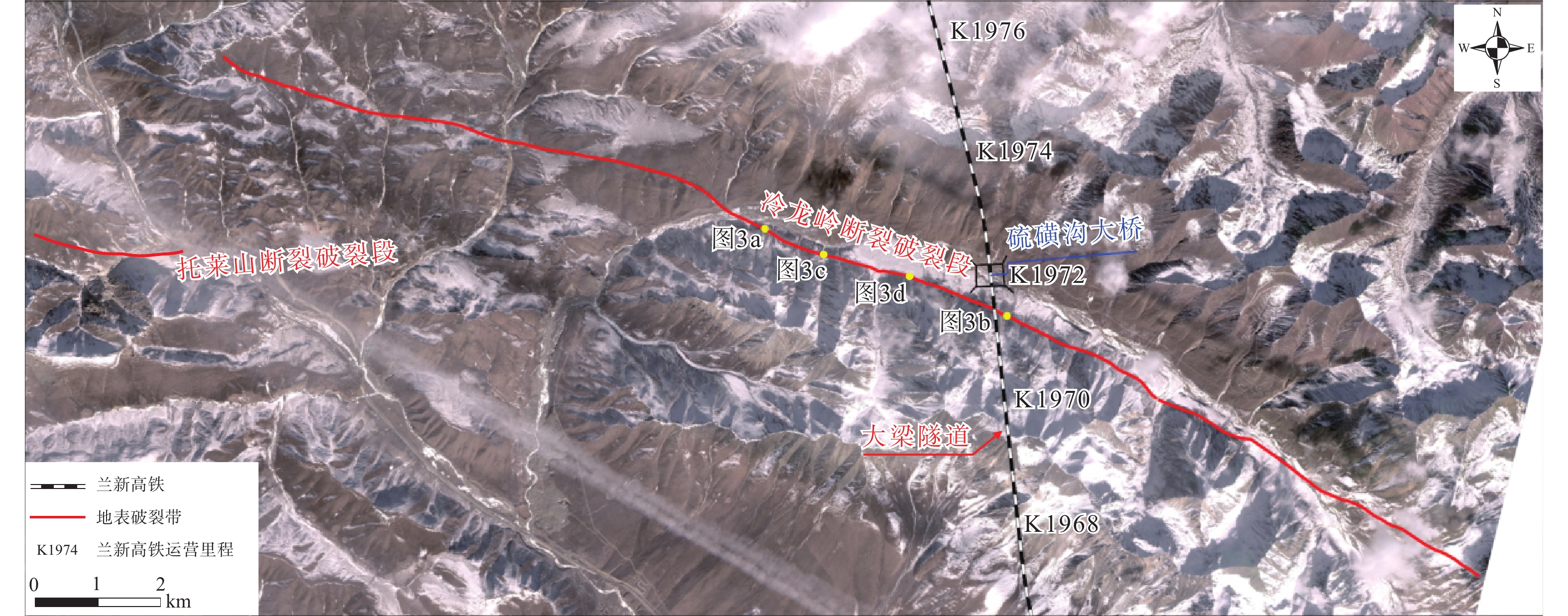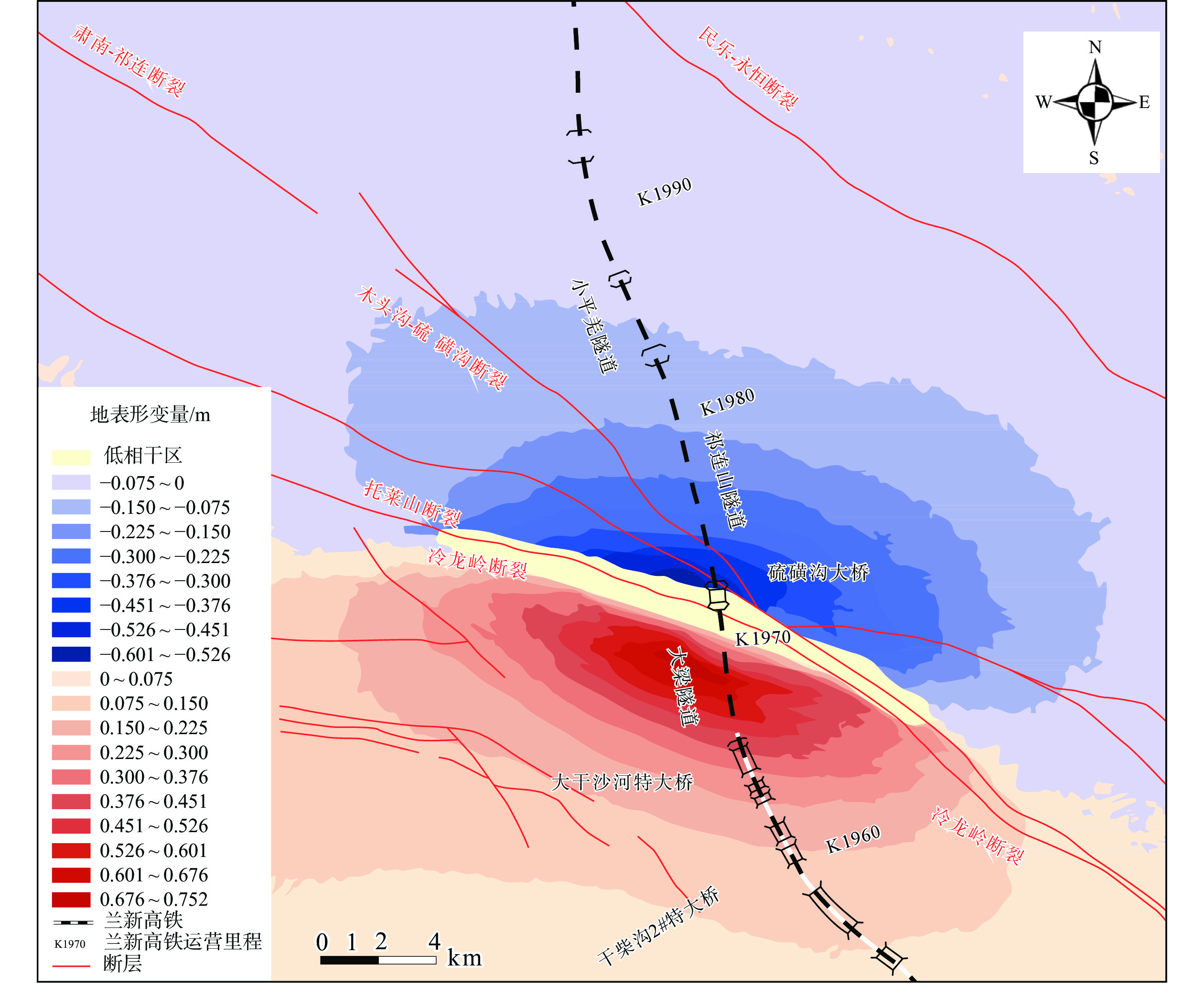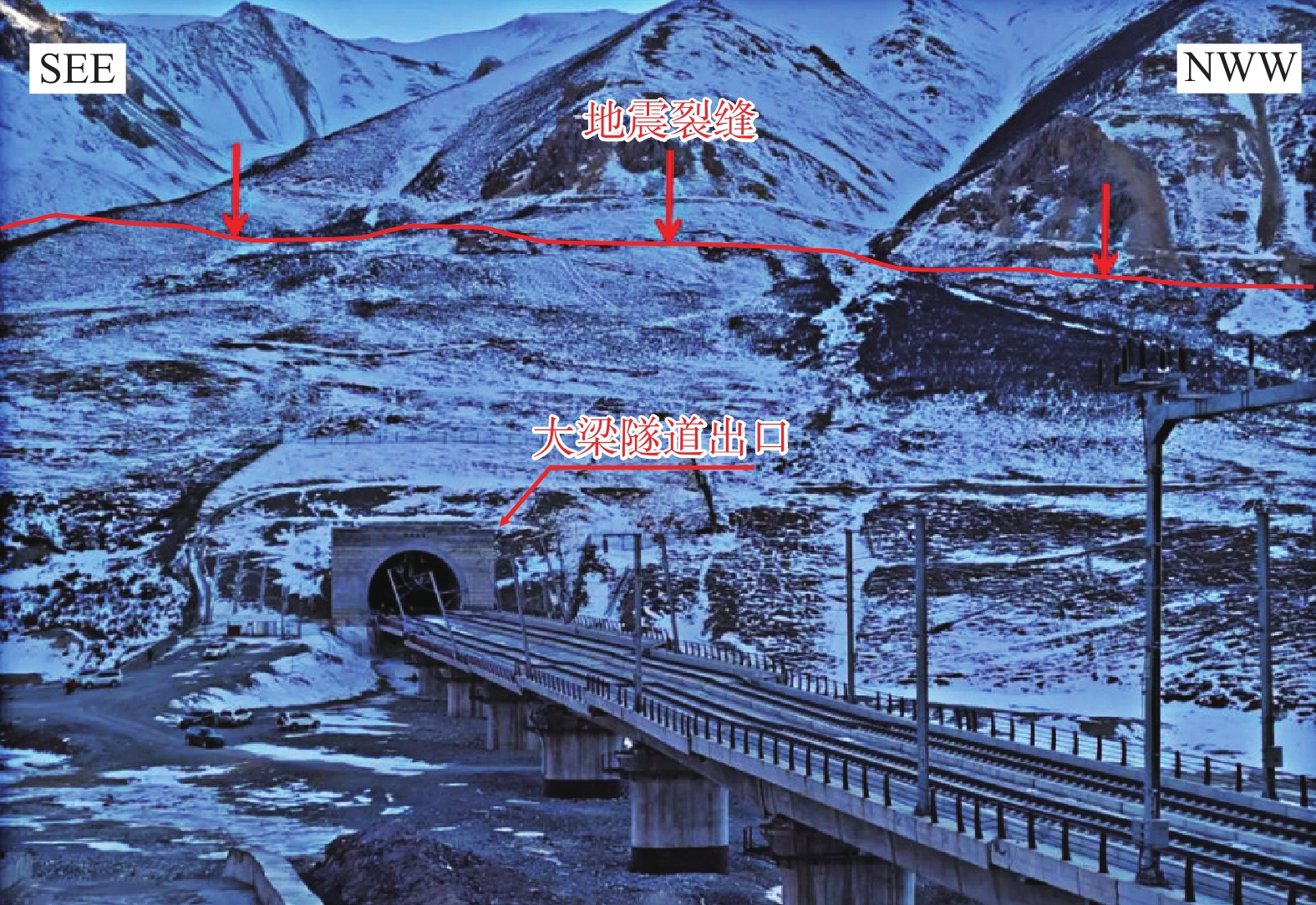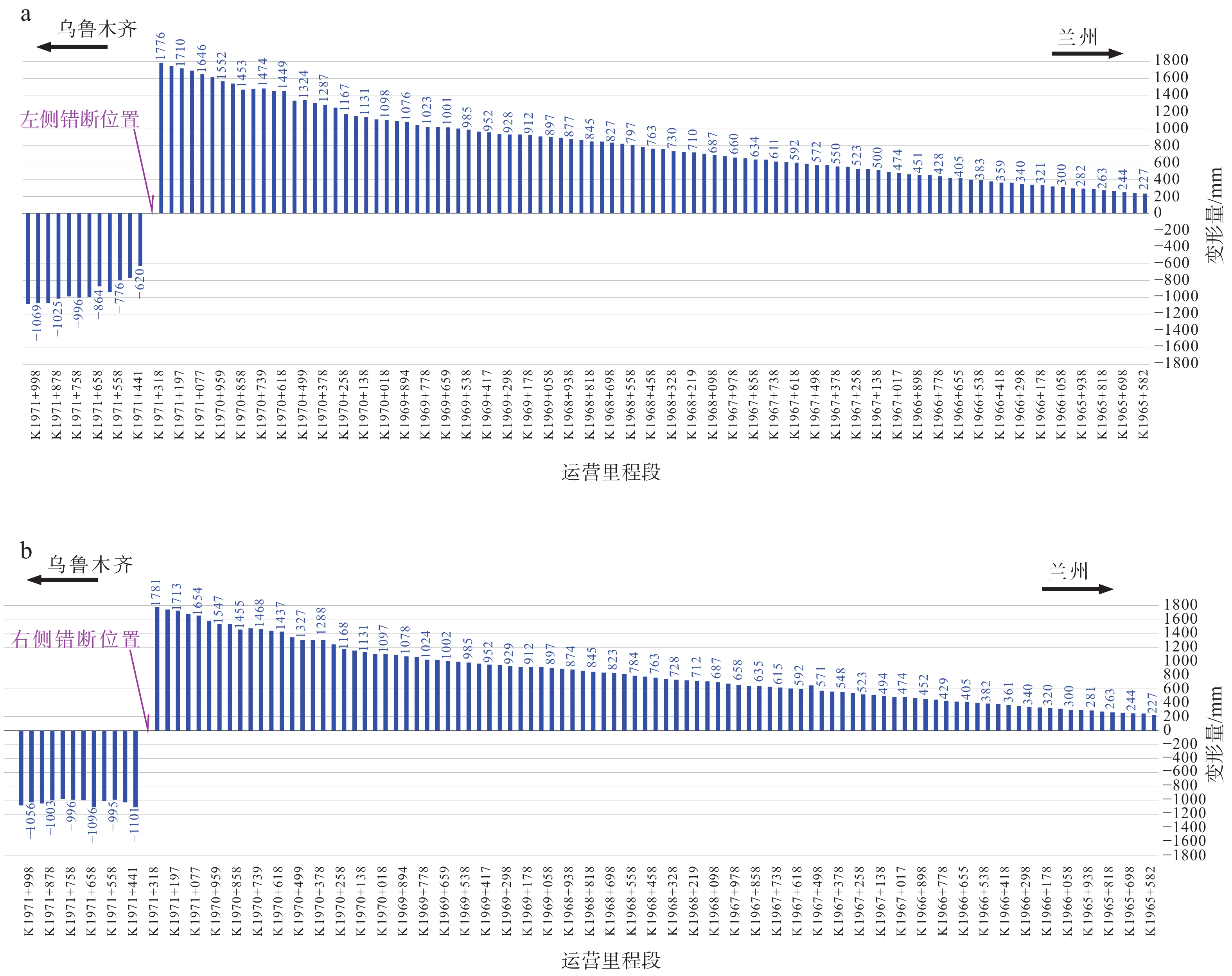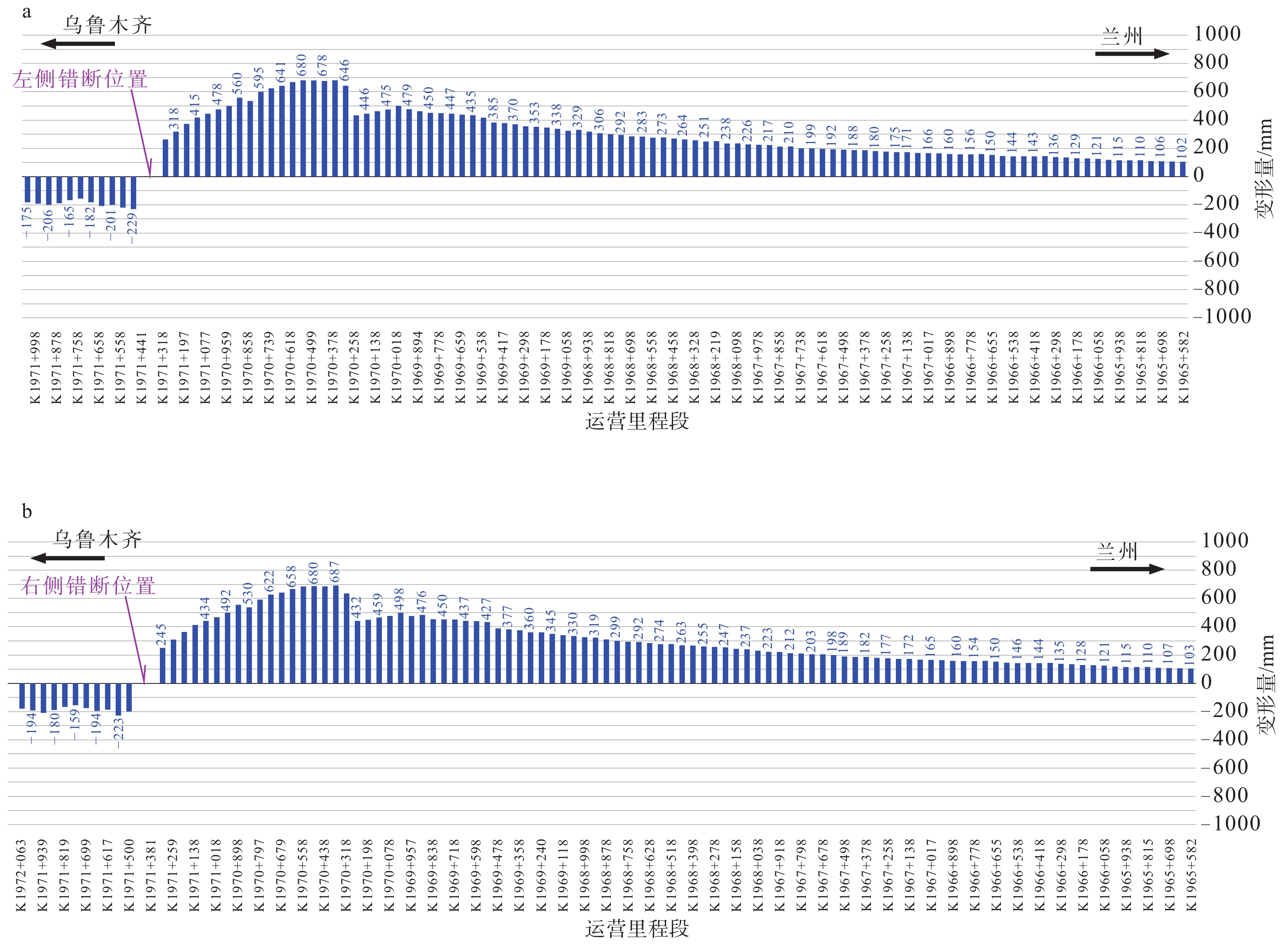The tunnel damage effects and implications of the coseismic rupture of the Menyuan MS 6.9 Earthquake in Qinghai, China
-
摘要: 2022年1月8日青海省门源发生MS 6.9地震,导致兰新高铁大梁隧道发生严重变形破坏。综合野外调查资料、InSAR地表变形数据及轨道控制网(CPⅢ)监测结果等,深入研究了青海门源MS 6.9地震同震破裂带对兰新高铁大梁隧道造成的变形破坏特征。结果表明,海原断裂带冷龙岭−托莱山断裂段为此次地震的发震断裂,并形成长约21.5 km的同震地表破裂,变形性质以左旋走滑为主,地表的最大左旋位移约为3.1 m。同震破裂带在穿过大梁隧道部位时,导致隧道工程发生严重损坏,最严重的变形破坏集中出现在主破裂带两侧各60 m范围内。对比隧道变形量观测结果和同震地表破裂变形特征可知,隧道区跨断裂的最大垂直位移约为91.6 cm,最大左旋位错量约为2.88 m,冷龙岭断裂与大梁隧道夹角约为60°,经换算后对应的发震断裂最大左旋位错量约为3.08 m,指示同震地表破裂的最大走滑位错量与穿过隧道的断裂最大位错量基本一致,表明隧道工程在显著的同震变形中难以起到抗断作用。此次研究成果可为类似穿越活动断裂带的铁路工程规划建设及震害防治提供科学参考与借鉴。
-
关键词:
- 门源地震 /
- 兰新高铁大梁隧道 /
- 海原断裂带冷龙岭−托莱山段 /
- 同震地表破裂 /
- 铁路隧道震害
Abstract: On January 8, 2022, a magnitude 6.9 earthquake occurred in Menyuan County, Qinghai Province, causing severe deformation and damage to the Da Liang Tunnel of the Lanzhou–Xinjiang high-speed railway, which is the first railway tunnel project broken by strike-slip earthquake in China. Through comprehensive analysis of field investigation data, InSAR surface deformation data, and monitoring results from the track control network (CPⅢ), this study delves into the characteristics of deformation and damage caused by the coseismic rupture zone of the Menyuan MS 6.9 earthquake on the Daliang Tunnel. The results indicate that the Haiyuan Fault Zone's Lenglongling–Tuolaishan fault segment is the seismogenic fault for this earthquake, forming a coseismic surface rupture zone approximately 21.5 km long. The dominant deformation nature is left-lateral strike-slip, with a maximum left-lateral displacement of about 3.1 m. As the coseismic rupture zone intersects the Daliang Tunnel, it severely damages the tunnel structure, with the most intense deformation and damage concentrated within 60 m on either side of the central rupture zone. Comparing the observed tunnel deformation with the characteristics of coseismic surface rupture deformation, it is evident that the maximum vertical displacement across the fault zone in the tunnel area is approximately 91.6 cm, with a maximum left-lateral offset of about 2.88 m. The angle between the Lenglongling fault and the Daliang Tunnel is approximately 60°, and the calculated maximum left-lateral offset of the seismogenic fault is about 3.08 m. This indicates a close alignment between the maximum slip offset from coseismic surface rupture and the fault's maximum offset across the tunnel, suggesting that the tunnel structure struggles to resist significant coseismic deformations. The findings of this study can serve as a scientific reference for the planning, construction, and seismic damage prevention of railway projects crossing active fault zones. -
图 3 海原断裂带冷龙岭—托莱山断裂段同震地表破裂(具体位置见图2)
a—铁丝网围栏左旋错位;b—地表破裂形成的地震陡坎;c—张裂缝;d—左阶雁行状挤压鼓包
Figure 3. Coseismic surface ruptures of the Lenglongling–Tuolaishan fault in the Haiyuan fault zone (The location is shown in Fig. 2)
(a) Left-lateral displacement of wire mesh fence; (b) Seismic scarp formed by surface rupture; (c) Tensile crack; (d) left echelon compressional bulge
图 8 大梁隧道线路CPⅢ平面变形量分布规律图
“+”为向隧道右侧(即北东东方向)位移;“−”为向隧道左侧(南西西方向)位移a—线路左侧(即隧道轴线西侧壁)CPⅢ平面变形量分布规律图;b—线路右侧(即隧道轴线东侧壁)CPⅢ平面变形量分布规律图
Figure 8. Distribution of CPⅢ plane deformation of the Daliang tunnel line
(a) Distribution of CPⅢ plane deformation on the left side of the line (the west side wall of the tunnel axis); (b) Distribution of CPⅢ plane deformation on the right side of the line (the eastern side wall of the tunnel axis) "+" indicates displacement towards the right side of the tunnel (north-east direction), and "−" indicates displacement towards the left side of the tunnel (south-west direction).
图 9 大梁隧道线路CPⅢ高程变形量分布规律图
“+”表示抬升量;“−”表示沉降量a—线路左侧(即隧道轴线西侧壁)CPⅢ高程变形量分布规律图;b—线路右侧(即隧道轴线东侧壁)CPⅢ高程变形量分布规律图
Figure 9. Distribution law of CPⅢ elevation deformation of the Daliang tunnel line
(a) Distribution of CPⅢ elevation deformation on the left side of the line (the west side wall of the tunnel axis); (b) Distribution of CPⅢ elevation deformation on the right side of the line (the eastern side wall of the tunnel axis) "+" represents uplift, and "−" represents subsidence.
-
[1] CHEN P, GENG P, CHEN J, et al. , 2023. The seismic damage mechanism of Daliang tunnel by fault dislocation during the 2022 Menyuan Ms6.9 earthquake based on unidirectional velocity pulse input[J]. Engineering Failure Analysis, 145: 107047-. doi: 10.1016/j.engfailanal.2023.107047 [2] CHEN X Z, LI Y N, CHEN L J, 2022. Investigation on variations of apparent stress in the region in and around the rupture volume preceding the occurrence of the 2021 Alaska MW8.2 earthquake[J]. Earthquake Science, 35(3): 147-160. doi: 10.1016/j.eqs.2022.06.002 [3] M N, et al. , 2018. Highway tunnel damage caused by earthquake and its mechanism crossing fault zone in Wenchuan Earthquake Area[J]. China Journal of Geological Hazard and Control, 29(2): 108-114. (in Chinese with English abstract) [4] CUI Z, SHENG Q, LENG X L, et al. , 2013. Effects of near-fault ground motion on seismic response of underground cacerns[J]. Rock and Soil Mechanics, 34(11): 3213-3220, 3228. (in Chinese with English abstract) [5] FANG L, GUO R, ZHENG B, et al. , 2019. Research on the seismic dynamic response characteristics of metro tunnels across faults[J]. Journal of Railway Engineering Society, 36(3): 72-77. (in Chinese with English abstract) [6] GAI H L, LI Z M, YAO S H, et al. , 2022. Preliminary investigation and research on surface rupture characteristics of the 2022 Qinghai Menyuan MS6.9 earthquake[J]. Seismology and Geology, 44(1): 238-255. (in Chinese with English abstract) [7] GAO F, SUN C X, TAN X K, et al. , 2015. Shaking table tests for seismic response of tunnels with different depths[J]. Rock and Soil Mechanics, 36(9): 2517-2522, 2531. (in Chinese with English abstract) [8] GAUDEMER Y, TAPPONNIER P, MEYER B, et al. , 1995. Partitioning of crustal slip between linked, active faults in the eastern Qilian Shan, and evidence for a major seismic gap, the ‘Tianzhu gap’, on the western Haiyuan Fault, Gansu (China)[J]. Geophysical Journal International, 120(3): 599-645. doi: 10.1111/j.1365-246X.1995.tb01842.x [9] GUO N, WU Y , ZHANG Q, 2022. Coseismic and Pre-seismic Deformation Characteristics of the 2022 MS 6.9 Menyuan Earthquake, China[J]. Pure and Applied Geophysics. DOI: 10.1007/s00024-022-03128-3. [10] GUO P, HAN Z J, AN Y F, et al. , 2017. Activity of the Lenglongling fault system and seismotectonics of the 2016 MS6.4 Menyuan earthquake[J]. Science China Earth Sciences, 60(5): 929-942. (in Chinese with English abstract) doi: 10.1007/s11430-016-9007-2 [11] HAN S, WU Z H, GAO Y, et al. , 2022. Surface rupture investigation of the 2022 Menyuan MS 6.9 earthquake, Qinghai, China: Implications for the fault behavior of the Lenglongling fault and regional intense earthquake risk[J]. Journal of Geomechanics, 28(2): 155-168,doi: 10.12090/j.issn.1006-6616.2022013. (in Chinese with English abstract) [12] HE W G, YUAN D Y, GE W P, et al. , 2010. Determination of the slip rate of the lenglongling fault in the middle and eastern segments of the Qilian mountain active fault zone[J]. Earthquake, 30(1): 131-137. (in Chinese with English abstract) [13] JIANG W L, , LI Y S, TIAN Y F, et al. , 2017. Research of Seismogenic structure of the Menyuan MS6.4 earthquake on January 21, 2016 in Lenglongling area of ne Tibetan Plateau[J]. Seismology and Geology, 39(3): 536-549. (in Chinese with English abstract) [14] JIAO Q S, JIANG W L, LI Q, et al. , 2022. Rapid emergency analysis of the surface rupture related to the Qinghai Menyuan MS6.9 earthquake on January 8, 2022, using GF-7 satellite images[J]. National Remote Sensing Bulletin, 26(9): 1895-1908. (in Chinese with English abstract) doi: 10.11834/jrs.20222043 [15] LEI D N, LIU J, LIU S M, et al. , 2018. Seismological tectonic model of the M6.4 earthquake in Menyuan, Qinghai Province on January 21, 2016[J]. Seismology and Geology, 40(1): 107-120. (in Chinese with English abstract) [16] LI P, YUAN J L, 1983. Some problems on active fault and engineering construction[C]//Selected papers of the first national engineering geology academic conference. Suzhou: Science Press. (in Chinese) [17] MA Y H,JIA H F,LI C Z,et al.,2021.Nearly-Horizontal Borehole Coring and Drilling Techniques in the Survey of A Railway[J].Geology and Exploration, 57(1):190-198.( in Chinese with English abstract) [18] MENG Q, GAO K, CHEN Q Z, et al. , 2021. Seismogenic, coseismic and postseismic deformation and stress evolution of the 2008 Wenchuan earthquake: Numerical simulation analysis[J]. Journal of Geomechanics, 27(4): 614-627. (in Chinese with English abstract) [19] MOLNAR P H, TAPPONNIER P, 1975. Cenozoic tectonics of Asia: effects of a continental collision: Features of recent continental tectonics in Asia can be interpreted as results of the India-Eurasia collision[J]. Science, 189(4201): 419-426. doi: 10.1126/science.189.4201.419 [20] PAN G T, LI X Z, WANG L Q, et al. , 2002. Preliminary division of tectonic units of the Qinghai-Tibet Plateau and its adjacent regions[J]. Geological Bulletin of China, 2002, 21(11): 701-707. (in Chinese with English abstract) [21] PAN J W, LI H B, CHEVALIER M L, et al. , 2022. Coseismic surface rupture and seismogenic structure of the 2022 MS6.9 Menyuan earthquake, Qinghai Province, China[J]. Acta Geologica Sinica, 96(1): 215-231. (in Chinese with English abstract) [22] SUNIL S, WILLIAN R J, LEI Q R, 1992. Earthquake damage to underground cavern[J]. Underground Space, 4(1992): 335-344. [23] WANG D Y, SUN Q Q, WANG K, et al. , 2019. Effect of local defect of surrounding , rock on lining stress of tunnel in Meizoseismal AREA[J]. Journal of Railway Engineering Society, 36(8): 73-78. (in Chinese with English abstract) [24] TAPPONNIER P, XU Z Q, ROGER F, et al. , 2001. Oblique stepwise rise and growth of the Tibet Plateau[J]. Science, 294(5547): 1671-1677. doi: 10.1126/science.105978 [25] WANG G X, LAI H B, 2012. Establishment and precision control of track control CPIII network of high speed railway[J]. High Speed Railway Technology, 3(1): 18-19, 23. (in Chinese with English abstract) [26] WANG X, JIANG W L, ZHANG J F, et al. , 2020. Deep structure of the gravity field and dynamic characteristics of the northeastern margin of the Tibetan Plateau[J]. Chinese Journal of Geophysics, 63(3): 988-1001. (in Chinese with English abstract) [27] WU Z H, 2019. The definition and classification of active faults: history, current status and progress[J]. Acta Geoscientica Sinica, 40(5): 661-697. (in Chinese with English abstract) [28] WU Z H, 2022. Active faults and engineering applications I: definition and classification[J]. Journal of Earth Sciences and Environment, 44(6): 922-947. (in Chinese with English abstract) [29] XU H C, 2019. Kinematics study of main active fault zones in the Northeastern Qinghai-Tibet Plateau[D]. Beijing: Institute of Earthquake Prediction, China Earthquake Administration. (in Chinese with English abstract) [30] XUE S Y, XIE H, YUAN D Y, et al. , 2022. Seismic disaster characteristics of the surface rupture of Menyuan MS6.9 earthquake in 2022[J]. China Earthquake Engineering Journal, 44(2): 458-467. (in Chinese with English abstract) [31] YUAN D Y, ZHANG P Z, LIU B C, et al. , 2004. Geometrical imagery and tectonic transformation of late quaternary active tectonics in northeastern margin of Qinghai-Xizang Plateau[J]. Acta Geologica Sinica, 78(2): 270-278. (in Chinese with English abstract) [32] ZHANG L C,ZHOU C,TANG J T,et al.,2022.Application of the Two-Component Wide-Field Electromagnetic Method to Engineering Survey of A Deep Tunnel [J].Geology and Exploration,58(4):857-865. (in Chinese with English abstract) [33] ZHANG P Z, DENG Q D, ZHANG Z Q, et al. , 2013. Active tectonic blocks and strong earthquakes in the continent of China[J]. Science in China Series D: Earth Sciences, 46(2): 13-24. (in Chinese with English abstract) [34] ZHANG P Z, SHEN Z K, WANG M, et al. , 2004. Continuous deformation of the Tibetan Plateau from global positioning system data[J]. Geology, 32(9): 809-812. doi: 10.1130/G20554.1 [35] ZHANG Y M, WANG Y J, ZHU Z Q, 2013. Damage evolution and distribution of underground cavern group under earthquake action[J]. World Earthquake Engineering, 29(4): 108-113. (in Chinese with English abstract) [36] ZHOU M D, LU T Y, ZHANG Y S, et al. , 2000. The geological structure background and the crustal structure in the northeastern margin of the Qinghai-Tibetan Plateau[J]. Acta Seismologica Sinica, 22(6): 645-653. (in Chinese with English abstract) [37] 崔光耀, 伍修刚, 王明年, 等, 2018. 汶川地震区跨断层带公路隧道震害形成机理分析[J]. 中国地质灾害与防治学报, 29(2): 108-114. [38] 崔臻, 盛谦, 冷先伦, 等, 2013. 近断层地震动对大型地下洞室群地震响应的影响研究[J]. 岩土力学, 34(11): 3213-3220, 3228. doi: 10.16285/j.rsm.2013.11.037 [39] 方林, 郭瑞, 郑波, 等, 2019. 跨断裂地铁隧道地震动力响应特征研究[J]. 铁道工程学报, 36(3): 72-77. doi: 10.3969/j.issn.1006-2106.2019.03.013 [40] 盖海龙, 李智敏, 姚生海, 等, 2022. 2022年青海门源MS6.9地震地表破裂特征的初步调查研究[J]. 地震地质, 44(1): 238-255. doi: 10.3969/j.issn.0253-4967.2022.01.015 [41] 高峰, 孙常新, 谭绪凯, 等, 2015. 不同埋深隧道的地震响应振动台试验研究[J]. 岩土力学, 36(9): 2517-2522, 2531. doi: 10.16285/j.rsm.2015.09.011 [42] 郭鹏, 韩竹军, 安艳芬, 等, 2017. 冷龙岭断裂系活动性与2016年门源6.4级地震构造研究[J]. 中国科学: 地球科学, 47(5): 617-630. [43] 韩帅, 吴中海, 高扬, 等, 2022. 2022年1月8日青海门源MS 6.9地震地表破裂考察的初步结果及对冷龙岭断裂活动行为和区域强震危险性的启示[J]. 地质力学学报, 28(2): 155-168,doi: 10.12090/j.issn.1006-6616.2022013. [44] 何文贵, 袁道阳, 葛伟鹏, 等, 2010. 祁连山活动断裂带中东段冷龙岭断裂滑动速率的精确厘定[J]. 地震, 30(1): 131-137. doi: 10.3969/j.issn.1000-3274.2010.01.015 [45] 姜文亮, 李永生, 田云锋, 等, 2017. 冷龙岭地区2016年青海门源6.4级地震发震构造特征[J]. 地震地质, 39(3): 536-549. doi: 10.3969/j.issn.0253-4967.2017.03.007 [46] 焦其松, 姜文亮, 李强, 等, 2022. GF-7卫星图像快速解析青海门源Ms6.9级地震的地表破裂带[J]. 遥感学报, 26 (9) : 14. [47] 雷东宁, 刘杰, 刘姝妹, 等, 2018. 2016年1月21日青海门源M6.4地震发震构造模式[J]. 地震地质, 2018, 40 (1) : 107-120. doi: 10.3969/j.issn.0253-4967.2018.01.009 [48] 李玶, 苑京立, 1983. 有关活断层与工程建设的几个问题[C]//全国首届工程地质学术会议论文选集. 苏州: 科学出版社. [49] 马映辉, 贾宏福, 李成志, 等, 2021.某铁路勘察近水平孔取心钻探施工技术[J].地质与勘探,57(1):190-198. [50] 孟秋, 高宽, 陈启志, 等, 2021. 2008年汶川大地震孕震、同震及震后变形和应力演化全过程的数值模拟[J]. 地质力学学报, 27(4): 614-627. doi: 10.12090/j.issn.1006-6616.2021.27.04.051 [51] 潘桂棠, 李兴振, 王立全, 等, 2002. 青藏高原及邻区大地构造单元初步划分[J]. 地质通报, 2002, 21(11): 701-707. doi: 10.3969/j.issn.1671-2552.2002.11.002 [52] 潘家伟, 李海兵, Marie-Luce CHEVALIER, 等, 2002. 2022年青海门源M_s6.9地震地表破裂带及发震构造研究[J]. 地质学报, 96(1): 215-231. doi: 10.19762/j.cnki.dizhixuebao.2022125 [53] 王道远, 孙其清, 王凯, 等, 2019. 强震区围岩局部缺陷对隧道衬砌受力影响分析[J]. 铁道工程学报, 36(8): 73-78. doi: 10.3969/j.issn.1006-2106.2019.08.015 [54] 王国祥, 赖鸿斌, 2012. 高速铁路轨道控制网CPⅢ建网与精度控制[J]. 高速铁路技术, 3(1): 18-19, 23. doi: 10.3969/j.issn.1674-8247.2012.01.005 [55] 王鑫, 姜文亮, 张景发, 等, 2020. 青藏高原东北缘重力场深部结构及其动力学特征[J]. 地球物理学报, 63(3): 988-1001. doi: 10.6038/cjg2020N0219 [56] 吴中海, 2019. 活断层的定义与分类——历史, 现状和进展[J]. 地球学报, 40 (5) : 661-697. doi: 10.3975/cagsb.2019.051001 [57] 吴中海, 2022. 活断层与工程应用Ⅰ: 定义与分类[J]. 地球科学与环境学报, 44(6): 922-947. [58] 徐化超, 2019. 青藏高原东北缘地区主要活动断裂带的运动学研究[D]. 北京: 中国地震局地震预测研究所. [59] 薛善余, 谢虹, 袁道阳, 等, 2022. 2022门源MS6.9地震地表破裂带震害特征调查[J]. 地震工程学报, 44(2): 458-467. [60] 袁道阳, 张培震, 刘百篪, 等, 2004. 青藏高原东北缘晚第四纪活动构造的几何图像与构造转换[J]. 地质学报, 78(2): 270-278. doi: 10.3321/j.issn:0001-5717.2004.02.017 [61] 张林成, 周聪, 汤井田, 等, 2022.双分量广域电磁法在深埋隧洞工程勘察中的应用 [J].地质与勘探,58(4):857-865. [62] 张培震, 邓起东, 张竹琪, 等, 2013. 中国大陆的活动断裂、地震灾害及其动力过程[J]. 中国科学: 地球科学, 43(10): 1607-1620. [63] 张玉敏, 王玉杰, 朱泽奇, 2013. 地震作用下地下洞室群损伤演化规律和分布特征[J]. 世界地震工程, 29(4): 108-113. doi: 10.3969/j.issn.1007-6069.2013.04.017 [64] 周民都, 吕太乙, 张元生, 等, 2000. 青藏高原东北缘地质构造背景及地壳结构研究[J]. 地震学报, 22(6): 645-653. doi: 10.3321/j.issn:0253-3782.2000.06.011 -






 下载:
下载:
